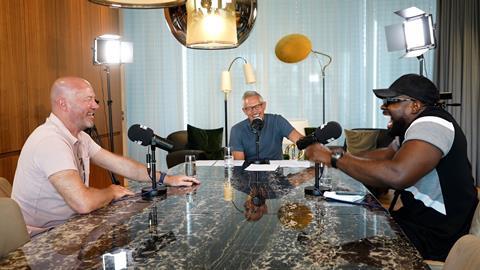Tom Cornish, global VP of group solutions at The Goat Agency looks at how creators are shaping the future of sport broadcasting

We’re less than a year away from FIFA World Cup kick-off - the planet’s most popular sporting event and the first edition to be held in three countries - and broadcasters are already compiling their mournful, Coldplay-backed montages to England’s inevitable knockout.
Okay, perhaps not quite yet - we’re currently ranked as second-favourites (not that that’s made much difference in the past). But what broadcasters do need to pay attention to is the growing momentum around how creator-led content intersects with traditional sports viewership.
Today, more than two in five (40.7%) global sports fans opt to stream live sports events through digital platforms, according to Nielsen. It’s a huge and growing demographic, reflecting both fans’ appetite for sports content and the explosion of media touchpoints. Meanwhile, new IPA research finds influencer marketing now outperforms linear TV and paid social for return on investment, delivering strong success, “particularly over the long term”.
Combined, livestreaming and influencers promise the greatest World Cup duopoly since Xavi and Iniesta. So, it’s no surprise that the creator economy is fast reshaping broadcast-fan engagement, and transforming how both media and sport should approach future consumption.
The creator economy goes up front
According to Deloitte, more than nine in ten Gen Z fans use social media to consume sports content. It’s why brands like Snickers and Mars have teamed up with football icons Jose Mourinho and Peter Crouch respectively to create viral social content that drives tens of millions of impressions.
Some influencers have risen purely from passion, building tight-knit fan communities such as AFTV through their relentless love of the sport. Others were already some of the games’ biggest stars. For example, take major-winning golfer Bryson Dechambeau, who went viral last November for hitting a hole-in-one over his own house. Both have recognised the opportunity to build their personal brands online. Now, even regulators are relaxing their rules around monetisation.
In the US, the National Collegiate Athletic Association’s recent ‘Name, Image, and Likeness’ (NIL) policy changes have fashioned a new class of creators: student athletes who aren’t just performers on the field, but peers with powerful, trusted voices for Gen Z. Now, US college athletes can profit from their brands and build highly engaged communities around schools and sports. With this NIL market projected to surpass $2 billion by 2026 by Opendorse, brands are taking notice - and opportunity is everywhere.
But what does this shift mean for traditional media, and the value of live rights?
Creator-led storytelling is a tactical tweak, not a threat
To remain relevant, broadcasters must evolve their approaches to content access. They can no longer afford to view creators as “add-ons” - they are vital partners in reaching and engaging the next generation of fans.
Strategic collaboration can deepen audience connection and extend the lifespan of sports content beyond live moments. Creator-led formats offer vital lessons on how broadcasters can meet ultra-modern viewing habits. The future of sports rights lies in hybrid partnerships, in which traditional media, brands and creators co-create value for fans and sponsors alike. And for some forward-thinking sports leagues, the future is already here.
2025 has so far delivered a quiet revolution in broadcasting and fan engagement. The Premier League’s global dominance, across both viewership and finances, has driven rival European leagues to strike groundbreaking deals with ‘alternative’ broadcasters in an attempt to draw eyeballs and coffers.
Goalhanger, the production company behind hits like The Rest Is History and The Rest Is Politics (co-owned by ex-footballer and TV presenter Gary Lineker), became the first podcast brand to secure official rights to weekly clips from a major European football league. The video editions of The Rest Is Football: LaLiga features LaLiga match highlights alongside expert analysis and discussion.
Perhaps even more unexpectedly, the Bundesliga announced that YouTuber Mark Goldbridge, best known for his viral Manchester United rants and live-match watchalong streams, had been selected to show 20 live Friday night matches across the 2025-26 season. Just a few years ago, traditional broadcasters would not have expected to share rights with creators like this.
With podcasts capturing loyal audiences and YouTube itself boasting over 122 million daily active users, the Spanish and German leagues are now heading where the fans are - instead of asking the fans to come to them. Broadcasters face missing out if they don’t take advantage of this trend.
How traditional broadcasters can stay onside
Ultimately, influencers are becoming as renowned and beloved as the sports stars themselves. Together, creators and broadcasters will need to work more collaboratively.
The smartest tactic isn’t to out-stream or out-hype the creators, it’s to build with them. Behaviour has already changed, audiences have already moved and value is sitting in different places. Media networks must explore partnerships with influencer agencies ahead of major global events to future-proof audience strategies and unlock new commercial opportunities. Ignore the rise of creator-led content, and traditional broadcasters risk being benched; not by viewers, but by the very platforms rewriting how fans experience sport.

Tom Cornish is global VP of group solutions at The Goat Agency





No comments yet